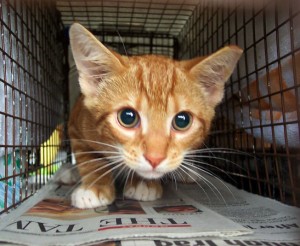
As this year’s kittening season approaches, animal rights organisations are renewing their on-going campaign to raise awareness about Dublin’s population of feral cats.
The seven month period from April through October are the months when the majority of kittens are born and concerned parties are keen to emphasise that irresponsible pet ownership is the main cause of the rising population of undomesticated felines. The animals pose a threat to tame cats, to which they can spread disease or injure more directly through their natural aggression and territoriality. If a kitten is not tamed within the first two months of its life, there is little hope for a domestic life. This leaves these populations of animals with nowhere to go.
In an urban context of abandoned retail outlets and undeveloped lots of property, the likelihood of coming across a litter of newborn kittens is higher than it might seem. The Irish Society for the Prevention of Cruelty to Animals estimated last year that feral cat populations in Ireland may be as high as 200,000 animals nationwide, which they characterised as “crisis levels”.
ISPCA’s affiliate group, DSPCA (the Dublin Society for Prevention of Cruelty to Animals) assert that 80% of kittens born are born wild and have an average lifespan of less than two years. The most effective way to prevent this situation is for people to have their pets spayed or neutered. NewsFour wanted to know what other countermeasures could be undertaken so we contacted Maureen O’Sullivan, Independent TD for Dublin Central, an animal rights enthusiast who explained, “Myself and Deputy Clare Daly have been working on amendments to the new Animal Welfare Bill; we were advocating a national role out of the policy of Trap, Neuter, Return.” This is a strategy where the animals are rounded up, given medical attention such as vaccinations, spayed to prevent further breeding in the wild, and released.
She continued, “We have concerns about companies being called out to deal with ‘feral’ cats who are not feral at all and there are individuals and families who have lost the family pet cat through these agencies being too quick in their actions.”
The distinction between stray and feral is simple. The former is a pet that has wandered and become lost. A feral cat was born and raised wild, completely outside a domestic setting.
The DSPCA advise that should you come across a mother and kittens, under no circumstances attempt to separate the mother from her litter. Tame cats will miaow and be responsive to receiving food and water. Feral cats will hiss and exhibit hostility and fear. In either case, you are advised to contact the DSPCA at 01-4994700 and make arrangements for the animals to be placed in safe hands.
By Ruairi Conneely



